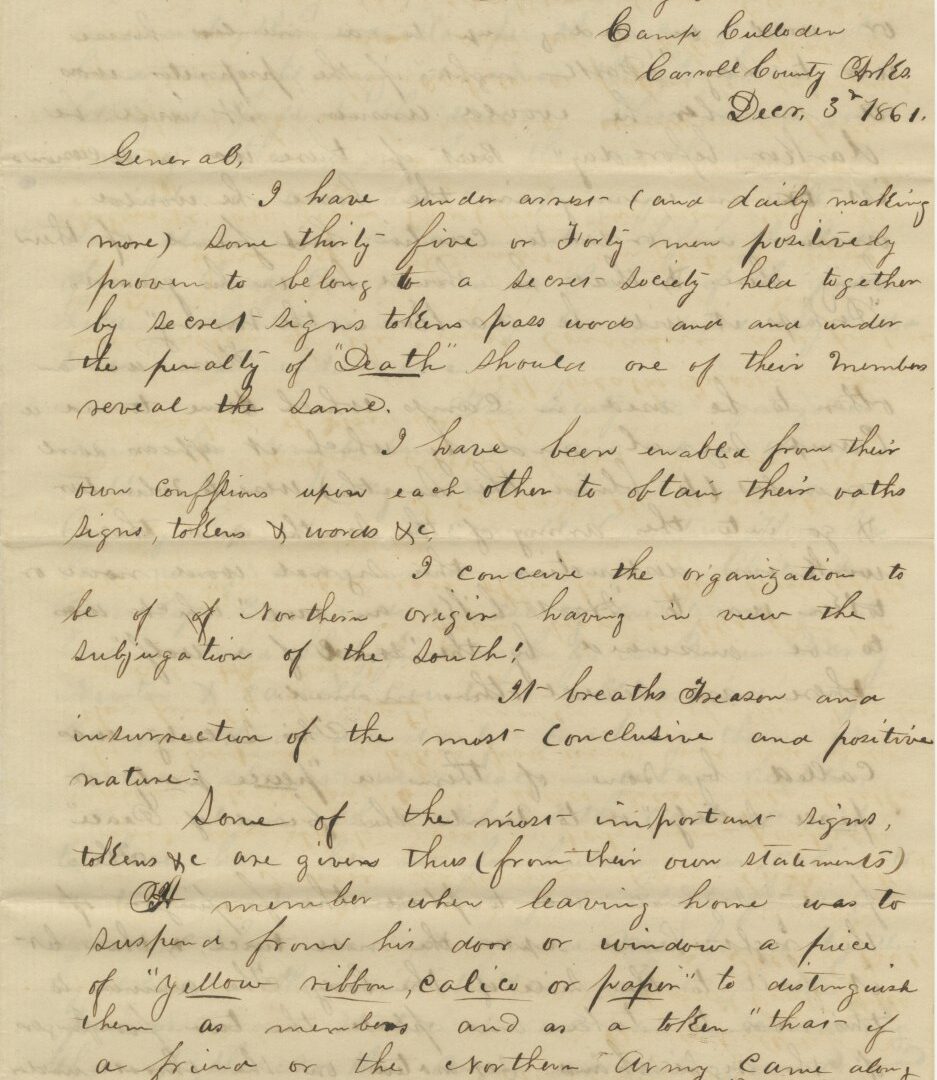“Treason and Insurrection”
Introduction
In December 1860, following the November election of Abraham Lincoln to the office of President of the United States, South Carolina became to first slave-holding state that seceded from the Union. By February 1, 1861, six more Southern slave-holding states seceded. On February 8, 1861, the seven rebel states (Alabama, Florida, Georgia, Louisiana, Mississippi, South Carolina, and Texas) formed the Confederate States of America, known also as the Confederacy. After the first shots at Fort Sumter were fired on April 12, 1861, four other states joined Arkansas, North Carolina, Tennessee, and Virginia. The eleven states were determined to preserve their slave-holding privileges.
That does not mean, however, that all white Southerners supported the Confederacy and its cause. While some did not agree with the official stand of the Confederacy but remained passive, others engaged in secret activities to fight against the Confederacy in the seceded South. One such initiative was the Arkansas Peace Society, a loose affiliation of anti-Confederate groups established shortly after Arkansas seceded from the Union. Those groups were usually secret because Confederates, who represented the majority of white Southerners, believed their members were traitors. The secret anti-Confederate groups in Arkansas were particularly popular in northern counties, where slavery was not as crucial to the economy as in other parts of the state. They did not last long, however. Most were disbanded already at the end of 1861 when the persecution of their members resulted in large-scale arrests.
In this activity, you will examine a letter that John Rice Homer Scott wrote to one of his fellow Confederate officers. In it, Scott discusses how the Arkansas Peace Society operated and what men like Scott – loyal to the Confederate cause – thought of anti-Confederate organizations. Although Scott was the great enemy of anti-Confederates, his letter allows us to reconstruct how these secret societies functioned in the South, where their activities were considered, in Scott’s words, “treason and insurrection.”
Activity Questions
Correspondence concerning John Rice Homer Scott and the Peace Society during the Civil War, item 5, page 1
- Who wrote the letter and when?
- What type of “secret society” does the letter’s author discuss? See “Introduction” for more information.
- Secret anti-Confederate organizations were distinctly created in the Southern Confederate states. That was because, in other states, individuals did not have to hide their anti-Confederate views. Why do you think Scott writes that the organization that he discusses was “of Northern origin,” which is not accurate?
- Why do you think Scott believes that the organization that he discusses “breaths Treason and insurrection of the most conclusive and positive nature”?
- How did the secret organization discussed in this letter operate? What kind of signs and secret signals did its members use to convey various messages?
- What does Scott mean when he writes that some members of the secret organization “were to volunteer & go into the army of the South and there work our destruction”?
- Where did the secret organization concentrate in Arkansas? Locate these counties on a map. If possible, use a map from 1861.
- What else do we learn about the secret society from Scott’s letter?
- How could Scott’s point of view (i.e., his views and beliefs) shape his description of the secret organization that he discusses in this letter?
- How did Scott obtain all the information about the secret organization that he discusses? See the first lines of the letter for important information.
- Although Scott opposed anti-Confederate groups and considered them treasonous, his letter allows us to study their history. Why do you think we can learn so much about those secret organizations from the letter of an enemy of such organizations?
Primary Sources
To learn more about the primary sources featured in the activities above, click the following links:
Arkansas Social Studies Standards
Social Studies (US History 1800-1900), Grades 8
- Strand: Era 5: Civil War and Reconstruction 1850-1877
- Content Standard 2: Students will analyze the American Civil War and Reconstruction and their effects on the social, economic, and political development of America.
- Era5.2.8.1 Develop historical arguments and explanations of causes of the Civil War using a variety of sources from multiple perspectives
- Era5.2.8.3 Analyze social and economic effects of the Civil War on America
- Era5.2.8.4 Analyze the historical significance of selected Civil War battles, events, and people
Arkansas History, Grades 7 – 8
- Strand: History
- Content Standard 7: Students will examine the impact of historical events and people on the development of Arkansas
- H.7.AH.7-8.3 Analyze the historical significance of selected Civil War battles, events, and people in various regions of Arkansas
Arkansas History, Grades 9 – 12
- Strand: Era 3: Civil War Through the Gilded Age 1861-1900
- Content Standard 3: Students will analyze factors that influenced the perspectives of Arkansans from the Civil War through the Gilded Age.
- Era3.3.AH.9-12.1 Analyze causes and effects of the secession of Arkansas from the Union using a variety of primary and secondary sources (e.g., state leaders, cooperationists, Secession Convention)
- Era3.3.AH.9-12.2 Research social, economic, and political effects of the Civil War on citizens in various regions from multiple perspectives
- Era3.3.AH.9-12.3 Analyze the historical significance of selected Civil War battles, events, and people in various regions of Arkansas
Key Terms
More Information
Downloadable Guides and Handouts
We encourage K-12 educators to use History Alive: Virtually! in a way that will best match their classroom needs. The “Exercise” handout includes a complete exercise as featured on this website, the “Primary Sources” handout includes only primary sources used in the exercise, and the “Questions” handout includes analytical questions from the exercise but is editable and can be easily changed to best match students’ needs.
“Treason and Insurrection” – Exercises


